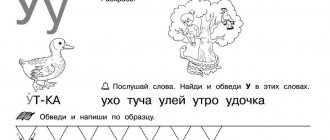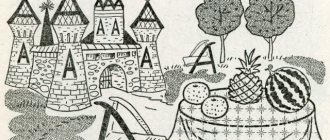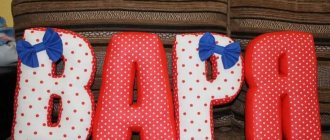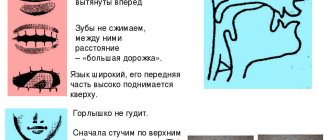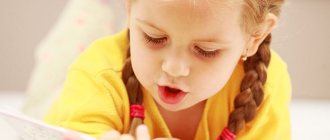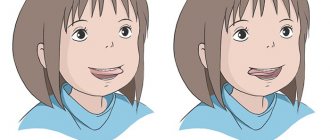Summary of the lesson “Sound [u], letter Uu.”
Literary reading (learning to read and write), 1st grade, UMK School of Russia
MBOU School No. 10, Rostov-on-Don, Pervomaisky district
Primary school teacher: Shutko Elena Leonidovna
Topic: Sound [u], letters U,u.
The purpose of the lesson
: Create conditions for students to become familiar with the vowel sound u, the letter u, u.
Tasks:
1. Develop the ability to analyze the sound composition, isolate the desired sound from a word and characterize it.
2. Introduce the letter U, teach them to recognize it in printed text.
3. Learn to apply acquired knowledge in a new learning situation.
Lesson type: lesson in acquiring new knowledge.
Key concepts: Sound u. letter U, y. Sound model of a word.
Methods and techniques of teaching: search and research
Planned results:
subject
perceive various types of texts by ear,
realize the purpose of reading in accordance with the content (I want to read poems about the letter “U”; I am interested to know which writers and poets write funny works for children);
read syllables and whole words with a gradual increase in reading speed;
meta-subject
express your assumptions regarding ways to solve a learning task;
personal
Show a positive attitude towards correct oral and written speech as indicators of a person’s general culture and civic position; know the features of pronouncing the sound u and its characteristics; call the letter U, y as a sign of the sound y; distinguish between printed and written, capital and small letters; find the letter being studied on the “letter tape”; make up a short story of a narrative nature based on a plot picture; learn to solve a puzzle; analyze words according to the model; make a proposal according to the scheme.
Regulatory: accept and maintain the learning task; adequately perceive the teacher’s assessment; evaluate the correctness of the action at the level of an adequate retrospective assessment.
Cognitive: general educational – consciously and voluntarily constructing a speech utterance in oral form; logical – build reasoning in the form of a connection of simple judgments; establish cause-and-effect relationships.
Communicative: understand the possibility of different positions of other people, different from their own, and focus on the partner’s position in communication and interaction; take into account different opinions and strive to coordinate different positions in cooperation; formulate their own opinions and positions.
They express a positive attitude towards the learning process: they show attention and a desire to learn more.
Equipment: Textbook “ABC”, part 1. Authors: Goretsky V. G. et al. Education, 2019;
Electronic supplement to the textbook by L.F. Klimanova, S.G. Makeeva (1 CD). ABC. 1 class. "Ribbon of letters." Notebooks for printing.
Summary of the speech therapy lesson “Sound and letter “U””
Group composition: 1st grade students. with OHP level 3 speech development
1. Warm up in a circle:
- Gross motor exercise: movement of the right arm, right leg forward, to the side, back and back; then the left hand, left leg in the same way, while simultaneously reciting the phrase “The mouse whispers to the little mouse”
- Large-motor exercise: “The hand catches up with the hand” - simultaneous walking in place with alternate movements of the hands on the belt, shoulder, above the head and back while counting or the rhythmic poem “Our Tanya is crying loudly”
- Exercise for hands “Fingers say hello” (the stage of simultaneous execution with both hands) with the simultaneous recitation of the poem “Chickens, geese and turkeys”
- Exercise with the ball “Which lasts longer?” - lesson or morning? - morning or afternoon? - Monday or week? - week or October? - October or autumn? - autumn or year?
2. Sitting at a desk:
- Clap your palms if the object is longer than the blackboard: notebook, office, desk, corridor, street
- How can you measure the duration of a lesson, day? What measuring device? — By the clock — What do we measure by the clock? - Time
How can you measure the length of a desk, blackboard, office, street? - Hands, ruler, tape measure, feet
3. Articulation gymnastics:
- "Window"
- "Frog - proboscis"
- "Pancake"
- “Delicious jam” - simultaneous movement of the tongue and hand (stage of synchronous execution)
- “Clock” - simultaneous movement of the tongue, index finger and eyes (stage of synchronous execution)
4. Announcing the topic of the lesson:
- Today we will study the sound that lasts longer in words: u-u-morning, ru-u-uki, mu-u-music - The sound “u” - How did you measure this sound? - Ears, hearing
5. Characteristics of the articulation of the sound “u”:
- lips extended with a “proboscis” - mouth open - vocal cords “tremble” - no “obstruction” - sound “u” - vowel
6. What words do you know with the sound “u”?
7. Determining the presence of a sound in a word, the game “Let’s fall asleep”:
- If there is a “u” sound in my word, you will wake up
8. Differentiation of the concepts “sound - letter” through biomotility:
- What we hear and speak are sounds - What we see and write are letters
9. The letter “y” is hidden in the upper right front corner of the office, show this corner with your right hand
10. Performing exercises while standing:
- To “write” the letter “y”, draw a line from this corner downwards to the left with your hand; point the hand to the upper left front corner, draw a line from this corner to the middle of the first line - the same is done with the head - the same is done on the surface of the blackboard - synchronous movement of the index finger and eyes - the same is done with the index finger of the right hand on the surface desks with determination of angles - starting points for writing letters
11. How many parts does the letter “y” have?
- Of the two - Which one is longer, the first or the second? - Second - How did you measure them now? - With your eyes
12. Work in a checkered notebook:
- writing a number - writing out the elements and the letter “y” with determining the corners of the cells - the beginning of writing a letter
13. Finding the correctly written letters “u” on the card
14. Finding the “correct” letter “y” on a card displayed in the mirror, tracing this letter on the card - looking in the mirror
15. Summing up the lesson:
— What did we go through in class today? — Sound and letter “U” — Differentiation of the concepts “sound - letter” — simultaneous pronunciation and pointing with hands to the ears, mouth, eyes, fingers
16. Constructing the letter “y” with cubes “Fold the pattern” by B.P. Nikitin
Explanatory note for the lesson
Neuropsychology is the science of the functional structure and interaction of brain structures, the development of which occurs at different times, from bottom to top (from stem, subcortical structures to the cortex), from right to left, from the posterior to the anterior.
By the age of 7, the child develops hemispheric lateralization. In speech, a preschooler has a dominant right hemisphere, while a schoolchild has a dominant left hemisphere.
Students who have a history of perinatal damage to the central nervous system, delayed speech and mental development, or level 3 ODD are enrolled in the school’s logo station. In such children, left hemisphere lateralization is delayed.
In this regard, it is important to develop the psychological basis of speech by means of neurocorrection:
- development of subcortical structures of the brain, ensuring the tone of the cortex and the development of motor acts;
- development of the right (“sensual, emotional”) hemisphere, emotions have a direct impact on the development of memory;
- development of interhemispheric connections (interaction between the right and left parts of the body when performing exercises).
The development of the psychological basis of speech is: elimination of large-motor, hand, finger, oral, articulatory apraxia; visual, auditory agnosia; constructive-spatial disorders, time orientation disorders.
Leading scientists of neuropsychology, A.V. Semenovich, B.A. Arkhipov, developed the program “Development of the psychological health of the child,” which is implemented in the “method of replacement ontogenesis.” On its basis, specialists develop proprietary programs.
Speech therapist O.M. Kozlova implements in her classes exercises used in speech therapy rhythms, therapeutic physical education, and sensorimotor correction.
Literature:
- A.V. Semenovich Introduction to the neuropsychology of childhood, textbook M.: Genesis. 2013
- O.A. Inshakova and others. Speech therapy support for primary school students, program and methodological materials M.: Education. 2014
Teacher - speech therapist MAOU "Secondary School No. 131", Perm: Kozlova Oksana Mikhailovna
Also on the topic:
Lesson summary “I hear. I'm talking. I'm reading. Sound [and] letter I"
